#Nordic Folklore
Explore tagged Tumblr posts
Text

Bet you didn’t think you’d learn what human and 100% troll Fass looked like today, did you? Or what his parents looked like. Or what he looked like as a human kid. Nope, betchu didn’t.
But anyway. A bunch of miscellaneous troll/changeling information just because. Also trolls are born as beans like bears. Just so everyone knows. Female trolls are called sows and males are called bores. That’s all.
#idk why#but I just really love how his mom looks#she’s very crunchy#fae#faerie art#troll character design#troll changeling#nordic folklore#folklore#character design#artists on tumblr#small artist#my art#young artist#digital art#regular style#changeling#faas art#tgb art#tgb#the grey in between#creature design#fae art#speculative biology#spec bio
369 notes
·
View notes
Text

Some nordic folklore creatures, but in (at least sort of) Gravity Falls style! :]
Got them here in separate pics + notes I tried to somewhat write as Ford. Though, I probably have massively failed 'cause I just can't replicate the fancy literature speak he does :')

Nisse
Might be related to Gravity Falls' own Gnomes, but with a few variations to them. For one, they are a little bigger than our resident Gnomes and have pointed ears instead of rounded ones. They also are more chaotic, but can become docile when given porridge of all things. And they tend to reside inside barns instead of the forest.
Such an interesting creature I wished I could speak to. However, whenever me and S have encountered one, they only speak in one of the languages of the nordic countries. They seem to understand us- calling us "turister," which a local have told us meant "tourists"- and absolutely despise us. Unless- like I mentioned earlier- we give them porridge. I would have to talk to the Gnomes and see if they have the same fascinations with porridge as these Nisse do.

Huldra
The locals I have talked to about Huldra have told a few different tales that either go one way or the other. Either they just want to get married, resulting in their cow tail popping off of them. Or they want to lure men away so they can kill them.
In a way, Huldra could be classified as a land version of a Siren. The only real big difference between one of these ladies and a regular woman is the cow tail I mentioned.
From what I have gathered, the Huldra have adapted a bit over the years to not only know the nordic languages, but also many other languages like English, Spanish, German, Hebrew, and so on. I do hope me and S can find one of them while we're here, I just hope it will not end in another rescue mission.

Nøkk
Nøkk- or Nøkken as some locals call them- is a creature that resides in lakes and sometimes rivers. Although it is probably one of the easier creatures to try and look for, we did not have the time to rent a car or walk all the way to one of these lakes that people had seemingly seen one in. Maybe some other day.
The descriptions of this creature, however, was still nonetheless interesting. It is mostly made out of algae and seaweed, has bright yellow eyes that gaze at you, and- during the full moon- can transform into a shining, white horse. The locals that have told me about this "horse form" have spoken about Nøkken luring people onto it's back before diving right into the water to drown them.

Draug
Draug- or Draugen- is a creature I have been advised to not encounter at all. The few that knew of it told of tales of sailors, fishermen, and seafarers alike stumbling upon this creature, then soon after meet their demise. Some have said Draugen is the one that kills them, some have said Draugen is simply there to warn of their upcoming death. No one is sure which is true as no one has met it and survived.
Another thing a select few locals have mentioned is how Draugen might have been once a human itself, but then met a tragic end out on the ocean. It would've been nice to try and speak to it, but considering the possibility of S and I dying as a result, I would rather not take the risk.
#For some of these fellas. I decided to put my own lil' spin on them.#The most notable one being Draugen. which I've decided to mix two interpretations of it.#I wanted Draugen to look like a regular fisherman from behind. but anything but from the front.#Nøkken. Nisse and Huldra pretty much look like a previous drawing of mine I've done of them. but I did change up Nøkken a lil' bit#And honestly. I like this version I did of Nøkken than the previous one :]#my art#Gravity Falls#Sorta#Nordic Folklore
151 notes
·
View notes
Text
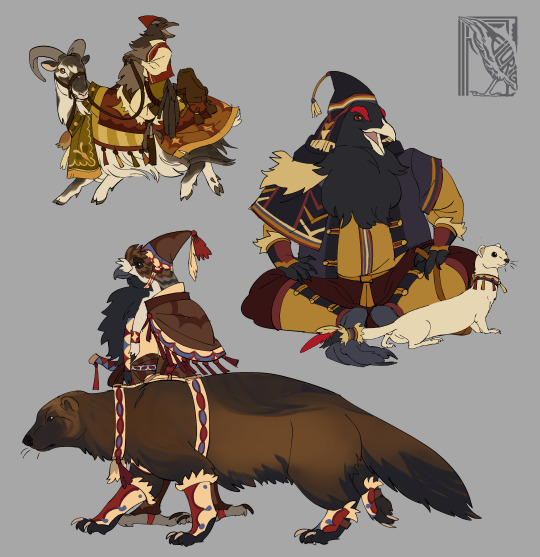
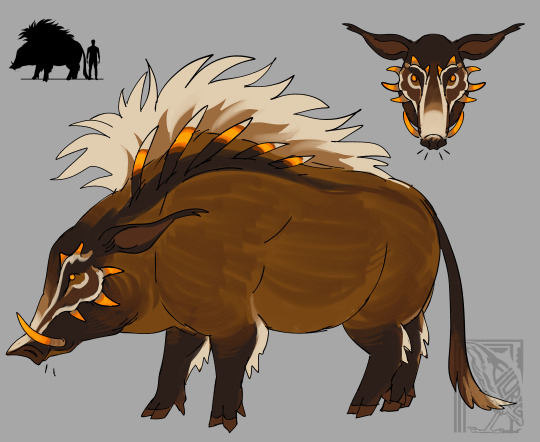
some stuff involving non sapient creatures in pareidolia, first image is some animals that tomtar have domesticated, second is a remake of gloson, which is a vätte but is, contrary to most other ones ive made, not a sophont and is instead domesticated by trolls. more info below the cut...
ive already talked about the tomteget in another post, so i wont go into detail about them here, but the one shown in the picture is gullmar's goat (and he is there as well as ucan see). tomtar also keep a domesticated breed of wolverine and ermine, used for some different purposes - wolverines more as guarding/herding animals and ermines to hunt. tomtar don't actually tend to hunt a lot of large prey at all, and what they do hunt is sort of limited as a lot of game birds are sacred to them due to folklore (basically ptarmigans, corvids, grouses, capercailles and things in those veins..). therefore despite how small ermines are they can hunt most of the quarry they prefer such as hares, ducks etc - especially bcs the tomte variety of ermine is bred to be a bit larger and more robust. they can also just be kept as companion animals for many tomtar. wolverines meanwhile serve well as guarding and herding animals due to their size and strength. there is a notable regiment of wolverine fighters in the midlands front - where interested tomtar are trained for combat utilizing the power of the wolverine - the one pictured though is a regular herding/guarding animal though. there are probably some smaller tomte hunting groups that try to go for bigger game with them such as wolves etc. but its definitely pretty unusual. tomteget goats are basically universal across tomte cultures, but the tomte wolverines and ermines are a bit more limited, more occuring in northern cultures historically. although as time goes on they have been spread further south, especially as the midlands front was established and increased the communicative network between different disparate tomte societies. 2. this is just a remake of the gloson from that older post bcs i wasnt really happy with the design - its a laaaaarge animal but didnt really feel like it proportionally bcs i stuck too closely to the normal eu swine proportions... things are mostly the same about them though. the orange parts of the horns glow!
#worldbuilding#fantasy#folklore#tomte#gnome#gloson#nordic folklore#spec bio#creature lore#pareidolia tag#bestiary#speculative fantasy#also i am gonna expand design possibilities for tomtar as u can see its not just limited to very ptarmigan/crowesque designs...#basically going to stick to grouse/ptarm/caperc. etc for the northern subsp.#and diff corvids for the southern subsp.#crosses between those can be a mix of both of course#oc: gullmar
275 notes
·
View notes
Text



I printed my own Christmas cards this year. Some of my cartoonist friends do this every year, but I usually forget about it until it's too late. The last time I did it was 2014 (ten years ago!). Since I used an old pic that most people already had seen, I wanted to make different drawings on the back side on each of them. The second one is probably the best drawing of a tomte (gnome) that I have ever done.
48 notes
·
View notes
Text
altars for nordic gods
keep in mind that altars like these have very little historical backing, and this information is mostly for the use of the modern pagan. also pretty much every god can be honored with offerings of meat, mead, wine, and your own blood.

ODIN
Colors: grey/silver for justice; deep blue, black for magic; red for war
Offerings: nine sacred herbs (chamomile, nettle, fennel, crab apple, mugwort, plantain, watercress, chervil, betony), runes, food for ravens, poetry
Crystals: sodalite, lapis lazuli, amethyst, lepidolite, obsidian, labradorite
Animals: his ravens (Huginn and Muninn), his wolves (Geri and Freki)
THOR
Colors: yellow, white, grey for thunderstorms; red for war; blue for the sky
Offerings: rainwater, hawthorn, oak, garlic, onion, hearty meals
Crystals: fulgarite, blue quartz/calcite, yellow jasper, sodalite, obsidian, hematite
Animals: goats
LOKI
Colors: black, green for mischief; yellow/gold for wealth; red, orange when he is combined with Logi
Offerings: yellow rattle, birch, mistletoe, snake shed, cinnamon, dandelion, coins/money
Crystals: labradorite, jade, malachite, pyrite, citrine, bloodstone, gemstones, serpentine
Animals: birds, horses, snakes, foxes
TYR
Colors: dark blue, silver/grey for justice; red for war
Offerings: holly, mustard seed, bread, oak, ash, good deeds are especially emphasized with Tyr
Crystals: lapis lazuli, sapphire, red jasper, bloodstone, obsidian, hematite
Animals: wolf, dog, bear, eagle
BALDR
Colors: gold/yellow, white for opulence; sky blue, pink for beauty
Offerings: chamomile, daisies, white blossoms, honey, juniper berries, laurel leaves, sunflower
Crystals: sunstone, celestite, selenite, pearl, rose quartz, pyrite, milky quartz
Animals: foal
FRIGG
Colors: blue, silver/grey, white for the moon; yellow/gold for opulence
Offerings: cardamom, allspice, sweet wines, milk, handspun fiber, feathers, moss
Crystals: moonstone, selenite, celestite, pyrite, milky quartz, rose quartz, agates
Animals: falcons, hawks, geese
HELA
Colors: red, orange, black for the underworld; white, grey for the dead
Offerings: white flowers, apples, willow, dark chocolate, coffee beans, mushrooms, clove--leave food until rotten
Crystals: bloodstone, jet, onyx, obsidian, black tourmaline, volcanic stone, red jasper, hematite
Animals: owl, raven, dog, wolf
FREYJA
Colors: red, pink, white for love; green, brown for nature; gold/yellow for her cape; purple, dark blue for magic
Offerings: jasmine, rose, verbena, collecting cat whiskers, honeycomb, fruit, fresh flowers, chocolate
Crystals: amber, petrified wood, agates, garnet/ruby, pyrite, lapis lazuli, rose quartz, emerald, jade, tiger's eye, cat's eye, amethyst
Animals: cats, pigs, horses, falcons
FREYR
Colors: green, brown for nature; yellow/gold for sunshine
Offerings: grain, apples, bread, nuts/seeds, venison, anything phallic, antlers, birch, hawthorn, coins/money
Crystals: green aventurine, agates, petrified wood, jaspers, jade, citrine, zoisite, pyrite
Animals: deer/stag, boar, horse, bee
NJORD
Colors: white, blues for the sea
Offerings: fish, sea salt, shells, beads, tobacco, fishing gear
Crystals: aquamarine, larimar, gemstones, pearls, malachite, sodalite, azurite, iolite
Animals: seabirds, sea mammals
SKADI
Colors: white, light blue for winter; brown for the hunt
Offerings: raw meat, berries, nuts, clear liquors, pelts, antlers
Crystals: milky quartz, bloodstone, blue calcite, chalcedony, jaspers
Animals: arctic fox
#witchcraft#pagan#paganism#polytheist#polytheism#witch#magic#magick#divination#witchblr#nordic paganism#nordic mythology#nordic folklore#altar#altars#deity worship#deity work#deity#deities#nordic gods#nordic pantheon
146 notes
·
View notes
Text
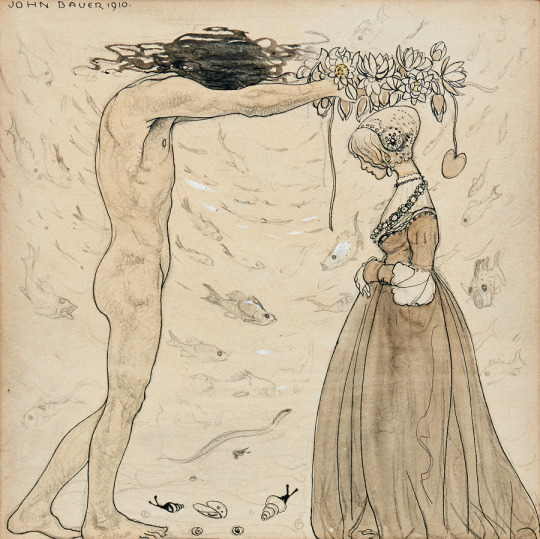
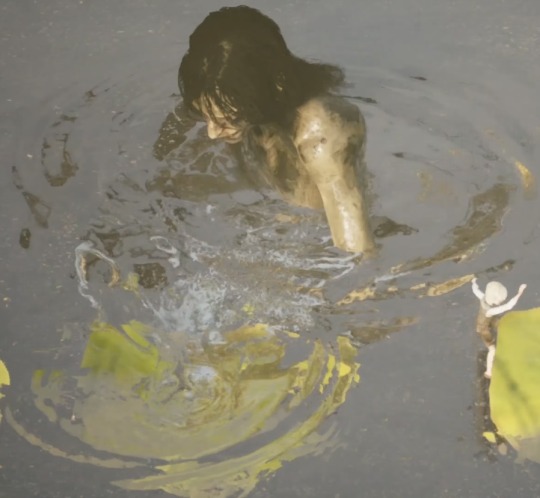
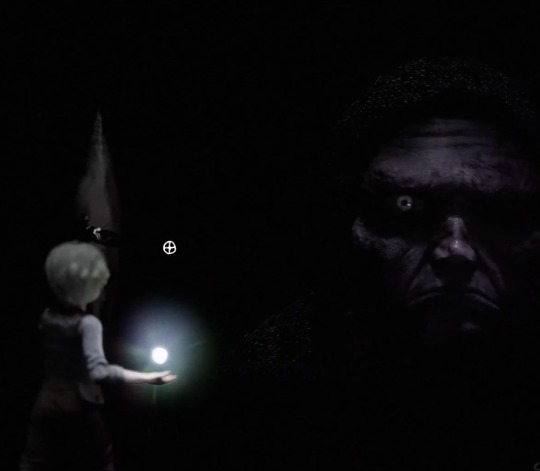


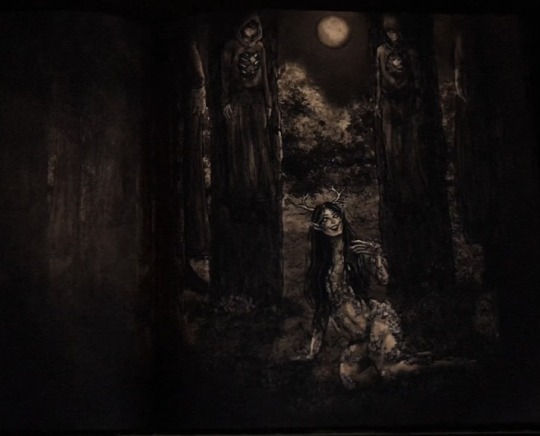

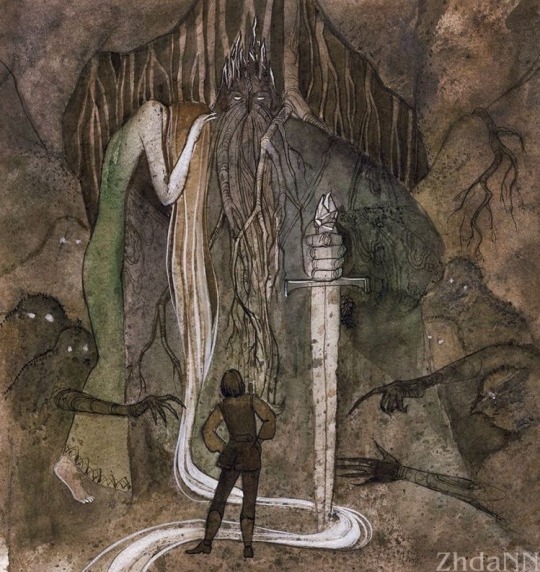
Bramble: the mountain king + John Bauer paintings
Part 2/2
846 notes
·
View notes
Text

Christmas illustration I did for a school project, so felt right posting it here
#artists on tumblr#original art#traditional illustration#christmas#christmas illustration#sankta lucia#school work#nisse#nisser#scandinavia#nordic#nordic folklore#original illustration#eva answers stuff#poster illustration#festive#holiday#colored pencils
35 notes
·
View notes
Text

as soon as I saw there was a red version of that chain dress with the hip cutouts, I knew Griseldir had to have it!
#fat art#art#chain dress#cutouts#griseldir the dragon#dress meme#dragon tamed#oc#draw your oc wearing this#troll#nordic folklore#let's just pretend this dress has more bust support than it would irl alright?
62 notes
·
View notes
Text
Life In A Christmas Tree

A Nisse of Nordic folklore looking happy in a Christmas tree at the Christmas Train Show. Photo credit: Jonathan Chua.
#photographers on tumblr#canon ef 50mm#christmas nisse#christmas photos#christmas tree#nikon photography#nikon zfc#nordic folklore#travel photography#travel pics
22 notes
·
View notes
Text
Hooooowww did people 1) hear the folksong Valravnen about a knight who's been transformed into a bird (likely an eagle, not a raven) and can only break the curse by killing a baby, 2) see that one (1) now-extinct noble family referred to their heraldic beast, a wolf/bird, as a 'valravn', and 3) read one single 1800s countryboy's explanation that valravnen is like an evil valkyrie, and SOMEHOW extrapolate from those three wildly unrelated sources that "The Valravn" (because it's never a folkloric concept with different interpretations, it's always a single specific creature) is a were-wolf/raven who haunts battlefields to drink the blood of slain warriors????
Please stop depicting 'the' valravn when you don't even know what it is, I'm begging on my fucking knees, I hate the way recent Danish folklore-inspired popculture has latched onto this figure and keeps depicting it in wilder and wilder ways😭😭
If you want a folkloric evil bird creature in your story please just use a fucking dragon or gammen. Use a damn cockatrice or vættehane, idgaf. Please just stop muddying the already-confusing lore of valravnen. The figure has been abused enough already and you are making my hobby as a folklorist very difficult😥
143 notes
·
View notes
Text

Tomtar
Two Tomtar. In english Tomtar is called Elfs, but it's not really the same thing. In the Nordic countries, there is a myriad of different folklore creatures called "Oknytt".
Tomten is perhaps one of the few that some people still believe in, at least a little. Although very few would openly admit so.
A very short description of the Tomtar. Just like humans, they are mortal. However, they live very long lives, perhaps 300-400 years. They also have some magical abilities. Most notably, the ability to turn invisible. They can also make their home invisible.
A Tomte is the protector and caretaker of a place. You can be certain that every old farm has one or several Tomtar looking after the place, even if it is abandoned. You can also find Tomtar in churches, castles, graveyards, barns and cottages. In fact, there is probably a Tomte in every building. Even newer ones.
Tomtar also resides in the forests. If a stretch of road running through or near a forest and has more accidents than usual then Tomtar may be the cause. They are probably angry at the traffic. Despite this, Tomtar are usually good and helpful as long as you do not anger them. If you do, they can be very vengeful.
Some things you absolutely should avoid if you want "your" Tomte to stay friendly:
Never be mean to animals
Never throw out hot water without first shouting a warning to the Tomte
Never forget to give porridge to the Tomte on Christmas
Never destroy large rocks or trees on your land unless you really have to. The Tomte will know if it was absolutely necessary or not.
Lastly, as I'm a nurse, I want to add that it is very common for people with dementia or mental disorders to start seeing Tomtar, or "smågubbar" meaning little people. It's so common that it has become a proverb. To say that someone is seeing "smågubbar" is to say that they are a bit crazy. It would be interesting to hear if this is the case in other places as well or if it is something specific to the Nordics.
#lego#brickcentral#afol#lego photography#toy photography#Tomtar#elfs#oknytt#tomte#folklore#nordic folklore
27 notes
·
View notes
Text

I started this painting August ninth. It’s now November fourteenth. It has been uncooperative to say the least. But honestly, I’m happy with how it finally came out.
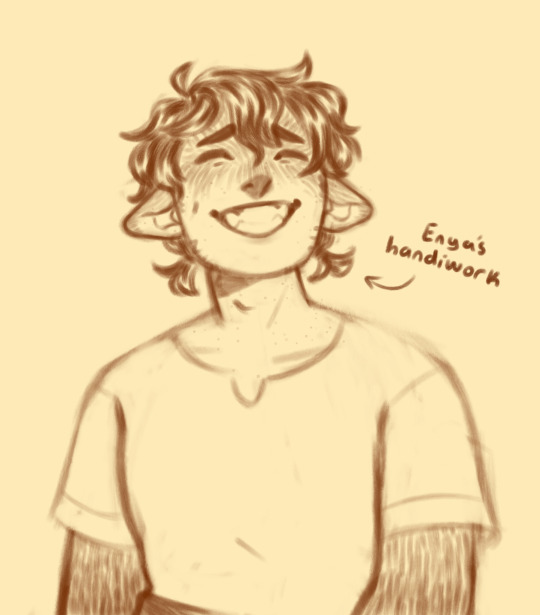
Also, Faas with pigtails because.
#this’s the first time I’ve drawn him properly smiling#he’s existed for over a year#and i feel bad that I haven’t let him smile ;-;#his character just doesn’t emote tons#but.#look at him#he’s so happy#also I’m sorry I haven’t posted actual art in a while#I’m in the stage of chipping away at fifty WIPs at once#and trying to finish them before the new year#and finishing art for the shop update#and#artists on tumblr#small artist#my art#digital art#character design#regular style#faas art#enya art#troll changeling#changeling#changeling art#kelpie#kelpie art#troll#scandinavian folklore#creature design#nordic folklore#folklore
64 notes
·
View notes
Text
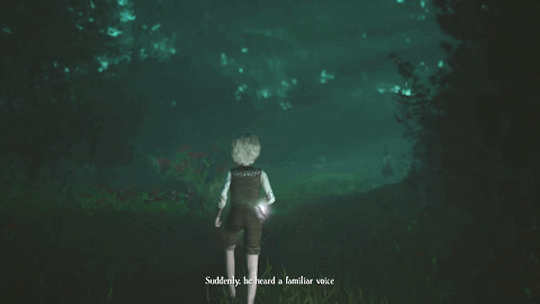
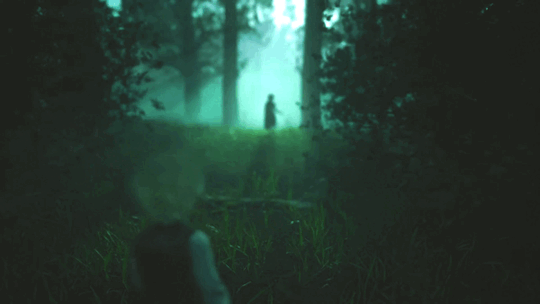



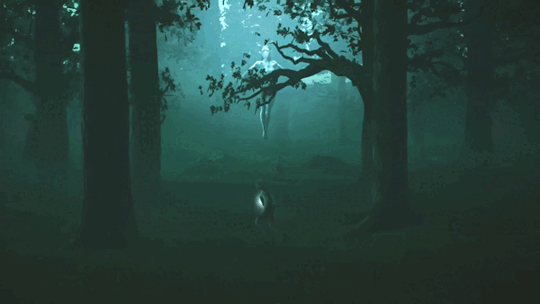
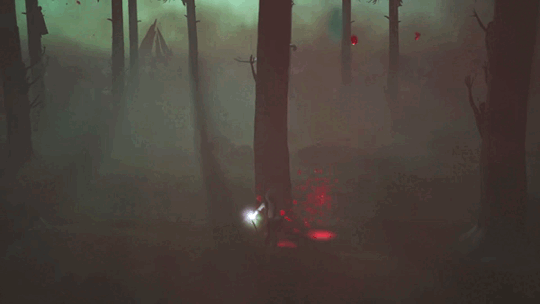
Bramble: The Mountain King (2023) | Skogsrå, 'The Mistress of the Forest'
"She was a shapeshifter that mimicked what men wanted to see in order to lure them away. When they were close enough to touch her, she would transform into something monstrous. She'd rip their chests open, hang them up in the trees and draw strange powers from their still-beating hearts. No one would ever see those men again…"
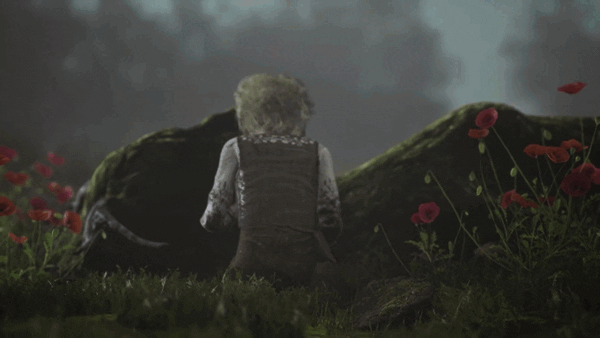
#the visuals in this game. the lighting and colors. absolute *chef's kiss*#bramble the mountain king#bramble: the mountain king#video games#fantasy games#favorite scenes#video game edit#video game gifs#gifs#animated gifs#folklore#nordic folklore#woods aesthetic#gaming#game edit#myedits#my gifs#dark fantasy#fantasy aesthetic#scenery#olle#skogsrå#mythical creatures
116 notes
·
View notes
Text
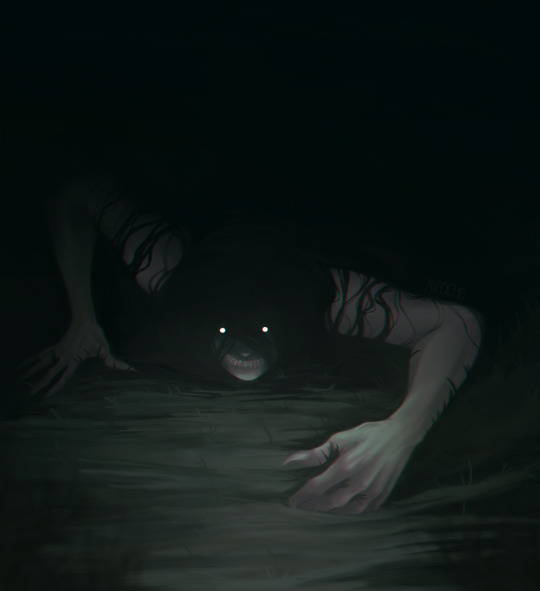
N Ø K K E N
#nøkken#nacken#folklore#scandinavian folklore#nordic folklore#idk what this even qualifies as#this fucker used to terrify me as a kid#my art#artists on tumblr#clip studio paint#digital art#digital painting#body horror#slight body horror i guess????#IDK HOW TO TAG
81 notes
·
View notes
Text

2: The Skogsrå from Bramble: The Mountain King
Bramble: The Mountain King is a horror and adventure game based on Nordic folklore. Naturally, the Skogsrå ("forest spirit", also known as the Huldra) is one of the bosses you have to fight. I think their design for the Skogsrå is really cool, even if they made her a bit more malicious than she was in folklore (she certainly was a dangerous creature, but she didn't kill people like that. Though considering it's supposed to be a horror game, the changes make sense).
202 notes
·
View notes
Text
understanding norse runes: a historical and modern perspective pt. 2
Here's part two! If you need clarification on anything please lmk! <3
For part 1 click here.

ᚺ hagalaz
ANGLO-SAXON:
"Hail is the whitest of grain;
it is whirled from heaven's loft
tossed about by wind gusts,
then melts into water."
NORWEGIAN:
"Hail is the coldest of grains:
Christ created the primaeval world."
(not the Christian Christ, just an epithet for Odin)
ICELANDIC:
"Hail is cold grain
and driving sleet
and sickness of serpents."
INTERPRETATION: Starting out strong, hagalaz thankfully only has one meaning, and that's "hail." Unrelatedly, this rune is also one of the first overtly negative runes (of course, the meaning truly depends on the surrounding staves you pull, but nevertheless), representing uncomfortable change, possibly a crisis. Associated with the goddess Hel, it represents both her aspects: the cold goddess of death, and the plentiful goddess of life. Hagalaz shows us that change is on the horizon, but that it will be a time of learning, of becoming evermore wiser. Similar to The Moon card in tarot, this stave also represents the secrets of the runes, the dark side. A side we nevertheless have to confront in order to overcome great stressors. Doubtlessly, this transformation will cause us some pain, but hail is considered the seed of possibilities. Though in solid form it may hurt or harm us, when melted it may nourish the struggling sapling. It has great potential, especially considering this is the ninth rune, a number that appears repeatedly in Norse Mythology. This stave has us confronting our worst fears and suffering, and telling us to learn from them, to become a better person. We have to create our own inner harmony, despite whatever may get in our way.
KEY WORDS: Disruption, upheaval, catalyst, potential
ASSOCIATIONS: Hel, the Norns (specifically Urdh, the past), Heimdall
ᚾ nauthiz
ANGLO-SAXON:
"Need is nearest to the breast,
yet often proves to children of men
a source of help and healing
if they heed it betimes."
NORWEGIAN:
"Need leaves little choice;
the naked man is chilled by frost."
ICELANDIC:
"Need is distress of thrall-woman
and state of oppression
and hard work."
INTERPRETATION: A rune often associated with the Norns, especially Skuld (the future), nauthiz is all about "necessity" and inevitability. The future is inescapable, but it can be used to our advantage. To understand this rune, we have to understand our own needs and purpose(s) as well. Usually, these are outside of our control. A lack of food caused by war creates a necessity for food. It is outside of the individual sufferer's hands. However, it can spur a person to act in whatever way they can, it's the spark of what is called the "needfire," vital to cause and effect. Need defines action defines life. Yes, this rune can be interpreted as a negative one, no doubt. But, again, runes are not as simple and straightforward as Tarot. If you pulled kenaz with nauthiz, you might look more closely at the "needfire" aspect of this reading, or if you pulled wunjo you might see this as more of a needs to an end. Which, really, that's all this rune represents: the needs to an end. You are not stuck in this state of lack, rather it is the lack that will turn the Norns' bow-drill to usher in a new era. Whereas hagalaz is more of a rigid, set in stone, nauthiz is about moving on from that suffering.
KEY WORDS: Necessity, inevitability, the future, constraint, hardship
ASSOCIATIONS: The Norns (specifically Skuld)
ᛁ isa
ANGLO-SAXON:
"Ice be overcold, unmeasurably slippery,
glisteneth clear as glass, to gems likest;
a floor by frost wrought, fair to be seen."
NORWEGIAN:
"Ice we call the broad bridge;
The blind man must be led."
ICELANDIC:
"Ice is bark of rivers
and roof of the wave
and destruction for doomed men."
INTERPRETATION: Isa, true to its similar pronunciation, just means "ice." In this way, it has two divinatory meanings: one as an unmoving, unwavering shield, and one as a static, frozen object/individual. It can help to lessen disturbances and chaos, to soothe the fires of the earlier runes. This stave can mean stasis, but it can also mean clarity, a deep concentration. Stuck in the ice, you would have an awful long time to think, no? Rest is important for all things, but especially so in times of chaos. When the fires of kenaz or thurisaz get too hot, isa is there to cool things down. Furthermore, though, this rune can represent an unwilling stagnation, a frustrating situation or relationship. Stuck quarreling with a lover, this rune would be emblematic of how the reader would be feeling in that moment. Similarly, we can take this rune to represent the present, the Norn Verdandi. As a rune of advice, the reader is being told to watch and wait, to get a lay of the land before continuing onward. As much as a swirling blizzard can freeze you out, an igloo can keep you safe from the perils of frostbite, so it all depends on the adjacent runes in the reading. What do you need before you can continue? What is the crux of what's holding you back? All of these are things you need to consider.
KEY WORDS: Stagnation, pause, waiting, patience, preservation
ASSOCIATIONS: The Norns (especially Verdandi)
ᛃ jera
ANGLO-SAXON:
"Summer is called joyful, when God lets,
holy heaven's king--shining fruits
be born from earth for rich and poor."
NORWEGIAN:
"Harvest is a blessing to men;
I say that Frodhi was liberal."
ICELANDIC:
"Harvest is a blessing to men
and good summer
and fully ripe crops."
INTERPRETATION: An often encouraging stave to pull in a reading, jera's literal translation is "year." In the harsher climates of the North, it is easy to lose track of the four seasons, and have the warmer and colder months blend together. In this way, jera represents not only summer, but also a good harvest. Every year, as the wheel of the year makes its rounds, crops must be yet again sown, cared for, and yielded. The old is reborn and the young turns to old. A symbol of dance, play, and marriage, this rune can also be associated with Freyja and Freyr, two deities strongly associated with the summertime. In divination, jera advises us to see everything as a constantly moving cycle. As soon as bad things come, they will leave, and good things replace them. Nothing is permanent, not even our most cherished. If blocked or neglected, a poor harvest is almost assured, and suffering is indicated. But when nurtured the right way, it can heal the deepest wounds and give rebirth to the greatest joys. An emphasis is also placed on creating new relationships and strengthening existing ones. Cherish your friends and family whenever possible.
KEY WORDS: Harvest, cycle, repetition, plenty
ASSOCIATIONS: Freyja and Freyr
ᛇ eihwaz
ANGLO-SAXON:
"The yew outside is a rough-barked tree,
but strong and firm, guard of fires,
by deep roots upheld, joy to the home."
NORWEGIAN:
"Yew is the greenest of trees in winter;
when it burns, it sputters."
ICELANDIC:
"Yew is bent bow
and brittle iron
and Farbauti of the arrow."
INTERPRETATION: Eihwaz is known as the "yew," and often represents Yggdrasil, the World Tree that Odin hung himself from over nine days and nine nights for the knowledge of the runes. Because of this, this stave often represents spiritual enlightenment, and connection between the physical and metaphysical realms. As the yew was consistently used for bow-making, this is a rune also associated with hunting and the wild (and furthermore masculinity, but I find that to be a bit sexist). A bridge between life and death, sky and earth, the heavens and the Underworld, eihwaz is a great rune for communing, divination, or necromancy. It is a connection between paradoxes, between opposites, and is also associated with graveyards. But no matter what, these connections have to be made thoughtfully, and with great trepidation. Carelessness has no place in this space, as it could just as easily turn from good to bad. -==32
KEY WORDS: Enlightenment, transformation, connection, paradox
ASSOCIATIONS: Odin, Yggdrasil
ᛈ perthro
ANGLO-SAXON:
"The chess piece means play and laughter
where in the middle, the warriors sit
in beerhall blithely together."
INTERPRETATION: Considering it was a letter commonly used, perthro has a fairly ambiguous meaning of "lot cup" or "game piece." Either way, the literal interpretation involves the drawing of lots, and chance. Divination wise, perthro is said to represent both the dice and the mode of throwing the dice, simultaneously mysterious and all-knowing. Considering this wealth of knowledge that perthro is said to contain, it is no wonder that it is heavily associated with Mimir, who is renowned for his wisdom. Furthermore, because of it's association with vessels (odd, I know), this stave also represents with the female womb and childbirth. For this reason, it is also associated with Frigg, a seeress and goddess of childbirth. Frigg, though she is said to know all, she also tells nothing. This doubles down on the mysterious, hidden powers of perthro, being both the runes themselves and their meanings. Additionally, being a rune of fate, it represents the Norns as a whole, and their powers.
KEY WORDS: Fate, luck, mystery, secrets, feminine energy
ASSOCIATIONS: Mimir, Frigg, Norns
ᛉ algiz
ANGLO-SAXON:
"Elk-sedge is found most often in fens,
waxes in water, wounds grimly,
with blood burns whatever warrior
that goes to grasp it."
INTERPRETATION: Aha! My favorite rune, how exciting. A rune meaning "elk," algiz is a powerful protective symbol. Considering the imagery of an elk, we can draw connections to god of the hunt, Freyr, who is often depicted with antlers. From Freyr we can then discern meanings of sexual awakening, the fighting spirit, and divine communication. With it's three pronged appearance we can create a number of different interpretations: the elements, a sacred forest grove, masculinity/femininity, the Yggdrasil, and even the Bifrost. I've also seen people consider it as a double-edged sword of a stave, a protective symbol but only as long as you have enough power and discipline to wield it. This is especially pertinent if we consider this as a rune of divine protection, as it would be doubtlessly foolhardy to demand protection from the gods while giving nothing in return. A weapon that can be wielded by you or against you.
KEY WORDS: Protection, guardian, sanctuary, the hunt
ASSOCIATIONS: Freyr
ᛊ sowilo
ANGLO-SAXON:
"Sun to seamen is a hope on high
when they ferry over the fishes' bath
until the sea-horse brings them to land."
NORWEGIAN:
"Sun is the light of the lands;
I bow to heaven's doom."
ICELANDIC:
"Sun is shield of the sky
and shining ray
and destroyer of the ice."
INTERPRETATION: Alright! Last one for this aett, sowilo means "sun." Not only the literal sun, this stave represents the force of the heavens, the wealth that it provides and the harm that it can cause. It brings illumination and clarification, as it also shows us where our path lays--what our goals may be. If we consider a connection between the sun god Apollo (a bright, beautiful youth) and Baldr (also a bright, beautiful youth), then new aspects can be revealed to us such as victory, strength, life force, and energy. It encourages us to have hope in our future, and to look towards the horizon. Just like the wheel of the sun whirls around the cosmos, so too does sowilo encourage us to break our stagnation and act. What we desire is within our grasp, all we have to do it reach out and grab it! This rune is one of great positivity and encouragement, and is a pleasure to see in a reading.
KEY WORDS: Success, illumination, achievement, energy
ASSOCIATIONS: Baldr
#pagan#paganism#polytheist#witchblr#witchcraft#polytheism#witch#magic#divination#magick#norse heathen#heathen#heathenry#norse pagan#norse polytheism#norse paganism#norse runes#norse gods#norse mythology#norse pantheon#norse#runes#runic divination#runic#runic magic#rune#nordic gods#nordic#nordic mythology#nordic folklore
40 notes
·
View notes